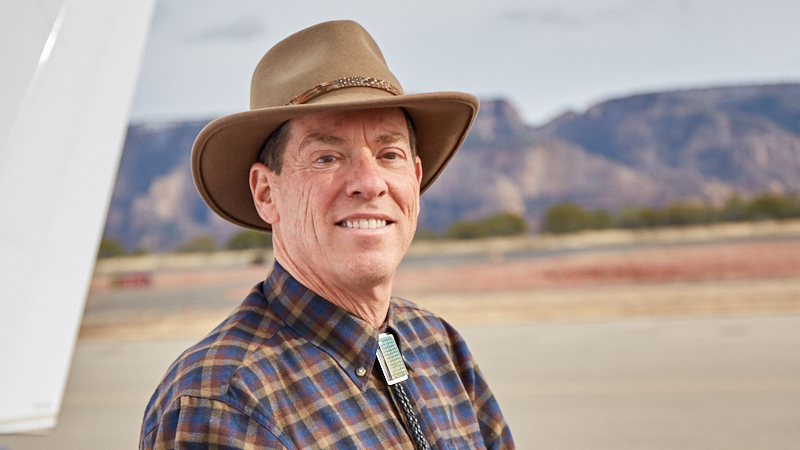Flying Carpet: Planning for Someday

Greg Brown and his wife, Jean, fondly remember an unplanned weather stop in Dalhart, Texas, marked by a memorable steak dinner.
www.gregbrownflyingcarpet.com
Along with budget and time constraints, that nebulous “someday” often arises from fear of the unknown. But any competent private pilot has the technical skills to execute such flights. Here’s how we tackle them from the human side.
If pressed by obligations, go early or make backup plans. There’s always a fair-weather day to make a given flight if we’re willing to wait for it. The risks arise when we “must” travel on a specific day. Jean and I set our one hard appointment this trip—my brother’s Chicago wedding—as our first destination, and allocated two travel days. When a tropical depression threatened Arizona and New Mexico that week, we canceled appointments, packed into the night, and departed a day earlier. We reached Chicago that evening well ahead of any threatening weather. Yes, we were two days early, but we made the wedding.
Inform your passengers (and those awaiting you). Throughout the journey, I briefed Jean on potential weather delays and diversions. Involving travel partners empowers them to support our decisions when plans change. Even when disappointed, enlightened passengers are impressed when we divert for safety reasons. When some of our hosts requested an exact schedule, I emailed: “Here’s our tentative itinerary. Lightplane travel can be unpredictable, so we’ll update our arrival dates en route.”
Focus on one leg at a time. Crossing the continent is simply a series of “routine” cross-country flights, strung together. Focus on safely completing the next leg, and don’t get hung up on what follows. Aviation author Richard Collins once observed that because bad weather is a product of an unstable atmosphere, it is by nature less predictable than good weather. Therefore, fair-weather forecasts are more often correct than bad-weather predictions. But only the current weather is 100-percent certain.
Know the big weather picture, and act on it. Maintain a current mental weather map to identify challenges and options. It’s often possible to skirt bad weather on long trips rather than confronting it, with little time penalty. Departing Flagstaff, our goal was to clear the Southern Rockies before the storm hit. From there, the Great Plains would offer more weather flexibility.
Separate fears from facts. Unfamiliar terrain, uncertain weather, border crossings—we’re all nervous when launching into the unknown. The trick is to ignore emotions as much as possible and base flight decisions strictly on facts. If the facts say flying is safe, ignore nerves and take off. If facts suggest unsafe conditions, don’t go. “Gut feel” is irrelevant. Homeward bound we faced thunderstorms across the Great Plains, but given good weather the first few hundred miles I squelched butterflies and took off. We made it home uneventfully.
Detach yourself from your destination. Before departing, Jean and I compiled a destinations wish list. We’d visit those we could, and let unplanned stops add to the adventure. On individual flight legs, define success not by reaching the planned destination, but by landing somewhere—anywhere—safely. Many pilots won’t launch into good weather if the destination forecast is unpredictable. So long as we commit to diverting if necessary, taking off usually delivers us where we’re going. (Jean and I made all our stops this trip.) Even diversion yields progress: We’re a step closer to our destination, and we’ve covered ground today that might be obscured tomorrow. And, hey—many of our best travel adventures arise from landing somewhere unexpected.
Plan ahead, travel in fair-weather seasons, and fly a well-maintained airplane. An instrument rating and instrument-capable aircraft can speed you along. But regardless, roll with the flow using the above principles, and you’ll safely complete your own cross-the-continent dream trip. Start planning it now, lest “someday” never comes!



